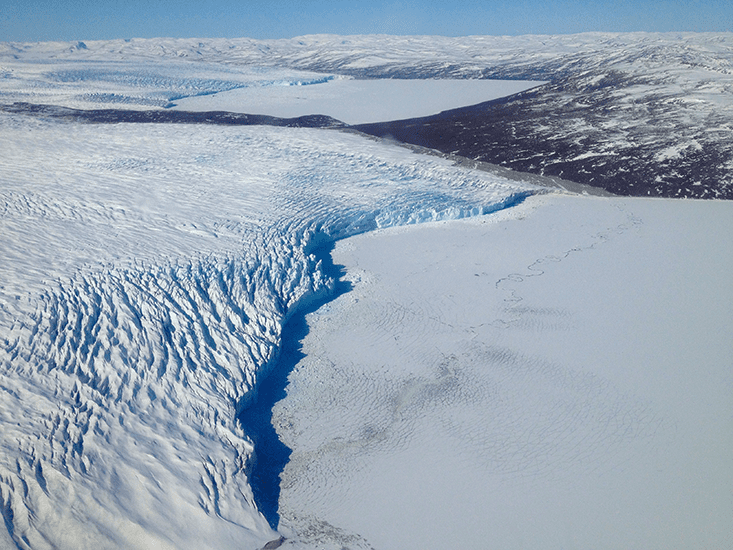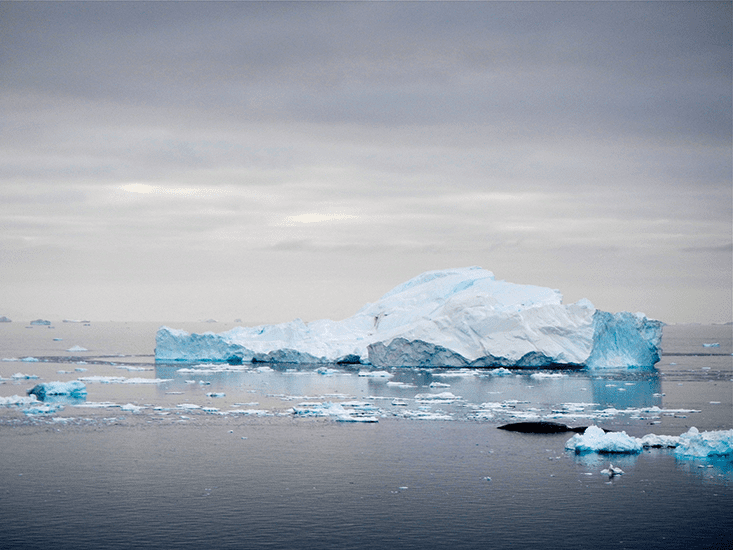A low-flying airplane buzzes along the coast of Greenland, hovering over a glacier. The belly of the plane holds a laser that bounces light off the glacier’s face. As the light beam returns to the plane, it enters a black box that slows it to a crawl, turning it into a moment-by-moment report on the glacier’s speed. Each flight, each glacier measured, allows researchers to map the diminishment of the Greenland ice cap. Similar planes skirt Antarctica and the coast of Alaska, charting the damage to the ice cover.
These airplanes and their experimental equipment don’t exist yet. But the need to measure glacier flow in real time does exist. The latest report by Intergovernmental Panel on Climate Change (IPCC) projected that melting ice may result in as much as one meter of sea-level rise by the year 2100, threatening millions of people in low-lying nations and coastal cities. Knowing how glaciers melt can help researchers predict the future. But glaciers are, well, glacial. Most of them creep roughly two to three kilometers each year, covering less distance than most of us can walk in an hour. The fastest ice flow in Greenland is the glacier Jakobshavn, which moves at the blazingly slow speed of about 16 kilometers in a year—about 180 centimeters per hour.
Currently, there’s no good way for ice scientists to measure such slow velocities in one measurement. All available methods require two takes—researchers measure the position of the ice face at different times and subtract them to get the average speed. In the old days, researchers would stick pegs at the edge of the ice and come back later in the year to see how far the ice moved. Today, these results can be achieved by radar-carrying planes that measure positions of glacier fronts, but this method also requires a return visit to average the speed. University of Colorado Boulder ice scientist Twila Moon relies on pictures taken by various satellites, which fly over Greenland and Antarctica at fixed times, but they also have to make two passes for a single measurement, and clouds can obstruct their view. “Sometimes you can wait months to get readings from one area,” Moon says. “For some areas we don’t get readings at all.”

Not only does the two-take technique require double the effort, but glaciers also advance and retreat irregularly, details which current tracking methods can’t capture. “Understanding ice sheet velocity is critical because the velocity is a key variable for understanding how much ice we are losing,” Moon says. “If we were able to get velocity data in a single look, the quantity and accuracy of the data would increase.”
The question is, how do you measure something that is moving as slowly as a glacier? To solve this challenge, University of Nice Sophia Antipolis physicist Umberto Bortolozzo and his colleagues turned not to something very slow, but to something very fast—light.
When a blaring siren moves toward us, its sound waves get bunched up, resulting in a higher pitch. Radar guns (like the kind used by the highway patrol) exploit this phenomenon, called the Doppler Effect, by bouncing radio waves off a car moving toward them to measure its speed. The faster the car is moving, the more the returning waves get bunched, reducing their wavelength. While a normal radar gun can’t measure very slow speeds, Bortolozzo and his colleagues are experimenting with a radar type that can.
They began by splitting a laser beam into two. One beam bounces off the slow-moving target whose speed is to be measured, a glacier for example, shifting its wavelength very slightly via the Doppler Effect. This color-shifted beam is then combined with the second beam inside a liquid crystal consisting of long, helical-shape molecules mixed with a dye. The dye molecules change their shape when they interact with the light, slowing it down to a speed less than one millimeter per second.
At full speed, the very small wavelength difference between the two light beams could not be detected. But the slow passage of the mixed beams through the liquid crystal strengthens their interaction (by increasing the so-called optical path distance), allowing the wavelength difference, and the target’s speed, to be measured.
In the lab, Bortolozzo and his coworkers have been able to detect speeds as slow as 20 millionths of a billionth of a meter per second (20 femtometers per second) with a measurement lasting only one second. This is more than sufficient for glaciers, which, on average, move on the order of a few millionths of a meter each second.

Unlike other slow-light techniques, that require cryogenic temperatures, this light-slowing method is easier to turn into practical use because it can be done at room temperature. That means any technology derived from these methods could be taken into the field without the need to carry liquid helium and bulky refrigeration units. Researchers hope this equipment can one day be loaded into an airplane that would circle the Greenland glaciers.
Moon hopes that day arrives reasonably soon. “If they can create an instrument that works like that and I can put it on the plane or an unmanned flying vehicle or a satellite, that would be great for our field,” Moon says. “Having such instruments would help decrease the uncertainty of how much sea level rise we are going to see and how quickly it’s going to happen.”
Matthew Francis is a physicist, science writer, public speaker, educator, and frequent wearer of jaunty hats. He’s currently writing a book on cosmology with the working title Back Roads, Dark Skies: A Cosmological Journey.



